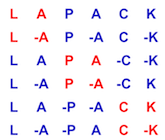 |
LAPACK 3.12.1
LAPACK: Linear Algebra PACKage
|
 |
LAPACK 3.12.1
LAPACK: Linear Algebra PACKage
|
| recursive subroutine clarft | ( | character | direct, |
| character | storev, | ||
| integer | n, | ||
| integer | k, | ||
| complex, dimension( ldv, * ) | v, | ||
| integer | ldv, | ||
| complex, dimension( * ) | tau, | ||
| complex, dimension( ldt, * ) | t, | ||
| integer | ldt ) |
CLARFT forms the triangular factor T of a block reflector H = I - vtvH
Download CLARFT + dependencies [TGZ] [ZIP] [TXT]
!> !> CLARFT forms the triangular factor T of a complex block reflector H !> of order n, which is defined as a product of k elementary reflectors. !> !> If DIRECT = 'F', H = H(1) H(2) . . . H(k) and T is upper triangular; !> !> If DIRECT = 'B', H = H(k) . . . H(2) H(1) and T is lower triangular. !> !> If STOREV = 'C', the vector which defines the elementary reflector !> H(i) is stored in the i-th column of the array V, and !> !> H = I - V * T * V**H !> !> If STOREV = 'R', the vector which defines the elementary reflector !> H(i) is stored in the i-th row of the array V, and !> !> H = I - V**H * T * V !>
| [in] | DIRECT | !> DIRECT is CHARACTER*1 !> Specifies the order in which the elementary reflectors are !> multiplied to form the block reflector: !> = 'F': H = H(1) H(2) . . . H(k) (Forward) !> = 'B': H = H(k) . . . H(2) H(1) (Backward) !> |
| [in] | STOREV | !> STOREV is CHARACTER*1 !> Specifies how the vectors which define the elementary !> reflectors are stored (see also Further Details): !> = 'C': columnwise !> = 'R': rowwise !> |
| [in] | N | !> N is INTEGER !> The order of the block reflector H. N >= 0. !> |
| [in] | K | !> K is INTEGER !> The order of the triangular factor T (= the number of !> elementary reflectors). K >= 1. !> |
| [in] | V | !> V is COMPLEX array, dimension !> (LDV,K) if STOREV = 'C' !> (LDV,N) if STOREV = 'R' !> The matrix V. See further details. !> |
| [in] | LDV | !> LDV is INTEGER !> The leading dimension of the array V. !> If STOREV = 'C', LDV >= max(1,N); if STOREV = 'R', LDV >= K. !> |
| [in] | TAU | !> TAU is COMPLEX array, dimension (K) !> TAU(i) must contain the scalar factor of the elementary !> reflector H(i). !> |
| [out] | T | !> T is COMPLEX array, dimension (LDT,K) !> The k by k triangular factor T of the block reflector. !> If DIRECT = 'F', T is upper triangular; if DIRECT = 'B', T is !> lower triangular. The rest of the array is not used. !> |
| [in] | LDT | !> LDT is INTEGER !> The leading dimension of the array T. LDT >= K. !> |
!> !> The shape of the matrix V and the storage of the vectors which define !> the H(i) is best illustrated by the following example with n = 5 and !> k = 3. The elements equal to 1 are not stored. !> !> DIRECT = 'F' and STOREV = 'C': DIRECT = 'F' and STOREV = 'R': !> !> V = ( 1 ) V = ( 1 v1 v1 v1 v1 ) !> ( v1 1 ) ( 1 v2 v2 v2 ) !> ( v1 v2 1 ) ( 1 v3 v3 ) !> ( v1 v2 v3 ) !> ( v1 v2 v3 ) !> !> DIRECT = 'B' and STOREV = 'C': DIRECT = 'B' and STOREV = 'R': !> !> V = ( v1 v2 v3 ) V = ( v1 v1 1 ) !> ( v1 v2 v3 ) ( v2 v2 v2 1 ) !> ( 1 v2 v3 ) ( v3 v3 v3 v3 1 ) !> ( 1 v3 ) !> ( 1 ) !>
Definition at line 160 of file clarft.f.